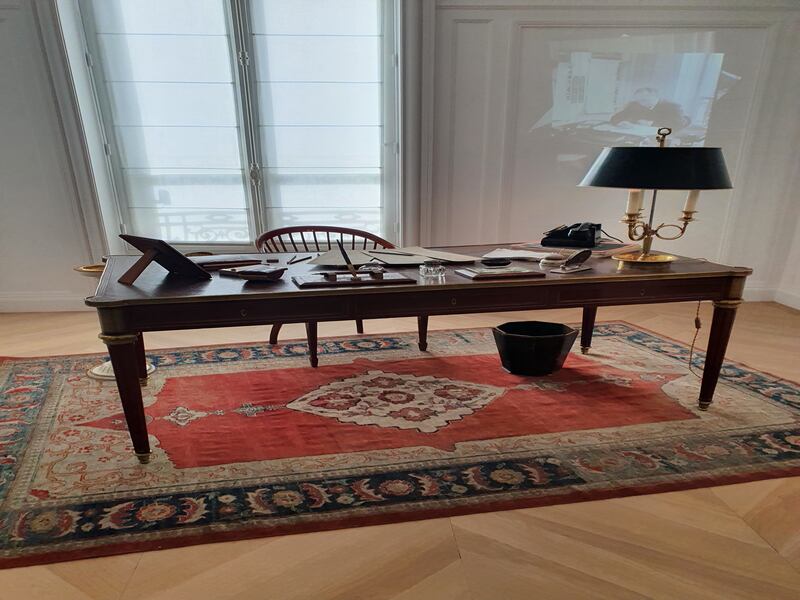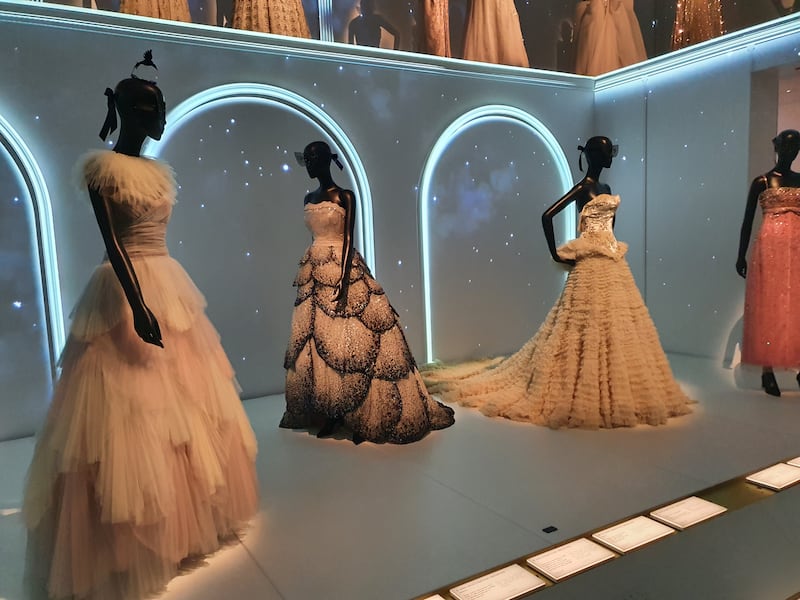For visitors to Paris interested in fashion, the latest imperative is the spectacular La Galerie Dior housed on the Avenue Montaigne, which opened in March and is attracting huge crowds. It is part of a major revamp of the historic flagship store founded by Christian Dior in 1946, which also houses the French luxury brand’s largest boutique worldwide.
The entrance to the Galerie sets the stylish and playful tone of this exhibition, which tells the story of the evolution of the famous Parisian house and the six creative directors who succeeded Dior — Yves St Laurent, Marc Bohan, Gianfranco Ferre, John Galliano, Raf Simons and Maria Grazia Chiuri. “This is how rich the history is of this 75-year-old house,” says our guide Olivier Flaviano, former director of the Yves St Laurent Museum in Paris, explaining that some of the archival material has never been on public display before.
The multicoloured diorama staircase which introduces the exhibition is a real showstopper. It features over a thousand miniature objects (including the famous Lady Dior bag), and dresses dating from 1947 to the present day in ascending colour spectrums as far as the eye can see. As you enter the building, a large oval-shaped white marble sculpture by Marc Quinn turns out to be the enlarged fingerprint of Christian Dior and part of the artist’s Labyrinth series — visual indexes of identity.

“[This exhibition] is a cultural project, part of the heritage of France encompassing seven different buildings,” Flaviano explains. “It is the largest permanent exhibition space dedicated to fashion in Paris in the hands of a private house.”
Bono calls for end to war in Gaza as U2 perform Sunday Bloody Sunday at Ivor Novello awards
Chef Nico Reynolds: ‘I’ve been spat on, jeered and beaten up, but I don’t think Ireland is a racist country’
Six Nations operator converts on-pitch success into €12.5m profit
Ireland must not follow England’s example on maintaining waterways
“A refuge of the marvellous” is how Dior described 30 Avenue Montaigne when it first opened with three ateliers, a tiny studio, a salon, a dressingroom for the models, an office and six small fitting rooms. What makes La Galerie special is that this is where it all started; Dior’s office and desk are exactly how they were, the cabine where his models prepared hair and make-up is like a time capsule observed through a glass floor, and there’s the famous staircase where models were photographed at the fashion shows which were held there until 1981.

“These spaces are at the heart of the presentation, an integral part of the building,” says scenographer Nathalie Criniere, who curated the space and was also responsible for the record-breaking Christian Dior: Designer of Dreams exhibition in Paris in 2017, which attracted more than 700,000 visitors.
Opening with the iconic Bar jacket that launched the New Look in 1947, the first of the 13 rooms contains outfits and archival material relating to the early years. There is a fascinating clip of Dior, whose first passion was architecture, in an address to the Sorbonne about his role as a couturier. “As a couturier I have to follow a dress in construction along the lines of cut and gravity and follow architecture’s laws and principles,” he explained.
Other rooms highlight the work of the brand’s subsequent artistic directors, including the more flamboyant creations of John Galliano and those of the present incumbent and first female head, Maria Grazia Chiuri.

Other rooms have titles that are self-explanatory: Stars in Dior, The Atelier of Dreams, An Invitation to Travel, Miss Dior and The Power of Gold. “What is important is that we are always trying to connect the past with the present,” says Flaviano, pointing out that the haute couture workshops above are always active; that this is still a working house.
Later that day there was an opportunity to see the Dior Haute Couture AW presentation in the Musée Rodin. The theme at the heart of the collection was the tree of life, and the work of Ukrainian artist Olesia Trofymenko, which Chuiri first encountered at an exhibition in Rome.

Long dresses with detailed embroidery in pale and muted shades of white and beige were paraded alongside large hand-stitched decorative wall installations created by Trofymenko and made at a famous craft school in Mumbai. The collection’s folkloric dress reimagined and modernised in quietly elegant ways had a look of serenity; the standout pieces were lavish opera coats with intricate embroideries, opulent black velvet dresses with lace inserts, fairytale pleating on silk chiffon and new variations on the Bar jacket and skirt.
In the sunny July weather in Paris, it was obvious that audiences and clients were back — tourists were everywhere — but Chuiri, with her weather eye on l’air du temps, stressed the importance of keeping jobs in haute couture alive in a post-pandemic world, reminding people that Dior set up his house just after the war, offering women hope and beauty in its aftermath.
It was also argued that continuing to present live rather than digital shows benefits the economy — the hotels, the taxis, the restaurants. And given that fashion is France’s second biggest industry with more than 600,000 jobs and a major contributor to its GDP, it’s about preserving livelihoods as well as craftsmanship. “We are conscious of our heritage, conscious of the importance of history and that fashion is part of the economy of France,” says Flaviano, completing the Galerie tour.















